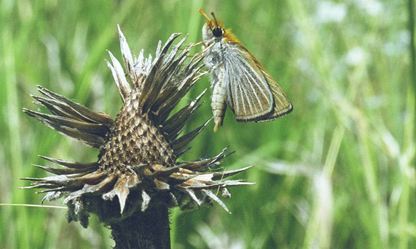



Cows and Butterflies: Why Private Grazing Lands Matter
Midwest ranchers may have been following the plight of two Butterflies which have dwindled from the rangelands in recent years. A range field specialist explores how they can be saved and why.
October 24, the US Fish and Wildlife Service published a proposal in the Federal Register to list two butterfly species that occur in eastern SD on the Threatened and Endangered Species List, write Pete Bauman, range field specialist at South Dakota State University.
The Poweshiek Skipperling is proposed to be listed as Endangered, while the Dakota Skipper is proposed to be listed as Threatened. The Service is also proposing critical habitat designations for both species that may include private land. The information provided here is considered preliminary as the proposals move through the listing process. See below for options to obtain more information.
History
These two butterfly species, once common on the pastures and prairies of the upper Midwest, have been monitored for decades by biologists. In the last decade, and especially in the last few years, the populations of both species have crashed and the butterflies are rarely found in even the best of habitats on public or private land in South Dakota.
Poweshiek Skipperling: A sunny day and a Coneflower
How did this happen?
Although there may be many factors contributing to the population loss, most biologists believe that one of the primary drivers of the downturn is the overall conversion of the grassland landscape. Many publications, both popular press and scientific, have reported the recent and rapid loss in grasslands. Observation of the relative lack of pheasants in the region helps in understanding that habitat is directly linked to species abundance, a phenomenon confirmed by scientific study.
Beyond the habitat losses, scientists assume that current pasture and cropland management may significantly impact non-target system and species. Largely, many biologists speculate that broad scale herbicide and insecticide applications may be a primary concern for non-target species such as butterflies.
Why does this matter?
Listing of any species as threatened or endangered can have impacts on both public and private lands management. For instance, the negative impacts of DDT in the 1940’s and 50’s led to the bald eagle being the face of the Endangered Species Act in the 1970s. In that case, listing saved our national symbol. In the current situation, butterflies and other species may serve as the catalyst to explore how we think about managing our private grasslands for the future.
How will this affect landowners?
The US Fish and Wildlife Service recognizes private grasslands as key to the historic and future preservation of these butterflies.
It is not likely that private landowners will feel the impacts of this proposed listing to any great degree, because the proposed rules would exempt most activities associated with traditional grazing management and the infrastructures associated with grazing.
Even in areas designated as critical habitat, private land managers will likely see little change in their operations if the proposed rules are adopted. Generally, the critical habitat area for both species in South Dakota includes roughly 27,000 acres of land occurring in parcels in Brookings, Day, Deuel, Grant, Marshall, Moody, and Roberts counties.
The critical piece to understand is that there may be some adjustments to how federal agencies accomplish their business on private lands. For example, listing could influence future US Fish and Wildlife Service and NRCS ranch and pasture management programs. So, understanding the details of this listing may be important to ranch operations in these counties.
So why does it matter?
It is important to understand that this may be the first serious ‘wake up call’ in regard to terrestrial grassland species decline in South Dakota. This may also be a great learning opportunity to participate in the solution to what might be a growing issue with grassland species management.
As the impacts of grassland loss and the loss of the diversity those grasslands harbor are realized, further challenges from additional federal regulation aimed at preserving species in decline are likely. A proactive approach now to improved pasture and grassland management for retention of species diversity may help preserve future management options.
Taking notice now and adjusting management to retain or improve profitability while simultaneously improving habitat through sustainable practices such as improved grass cover, root reserves, and forb diversity is vital. Overall management of grassland species diversity will likely be the key to future success and reduced government regulation for private rangelands.
What can be done?
The first step is engaging in the conversation and learning more about the situation. Grassland management resources, trainings, and tools provided through organizations like SDSU Extension, The SD Grassland Coalition, NRCS, the US Fish and Wildlife Service, SD Game Fish and Parks, and others are valuable.
Landowners are encouraged to participate in these educational programs when planning for the future of their operations.



